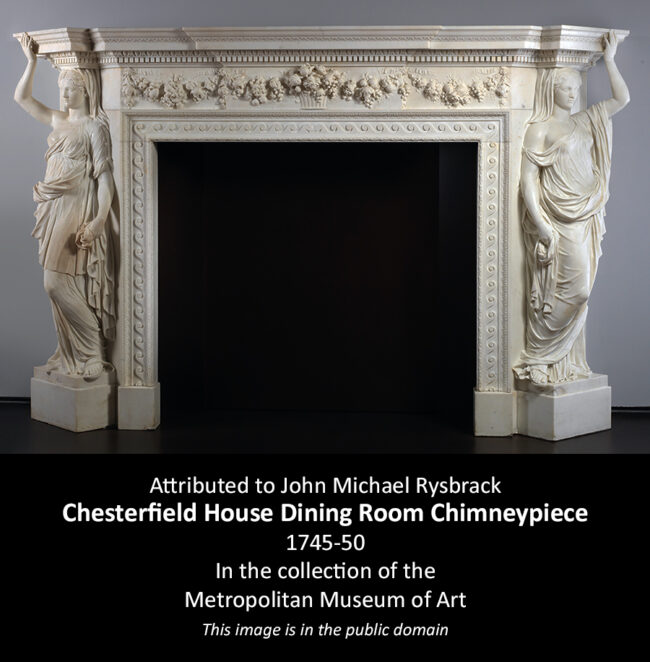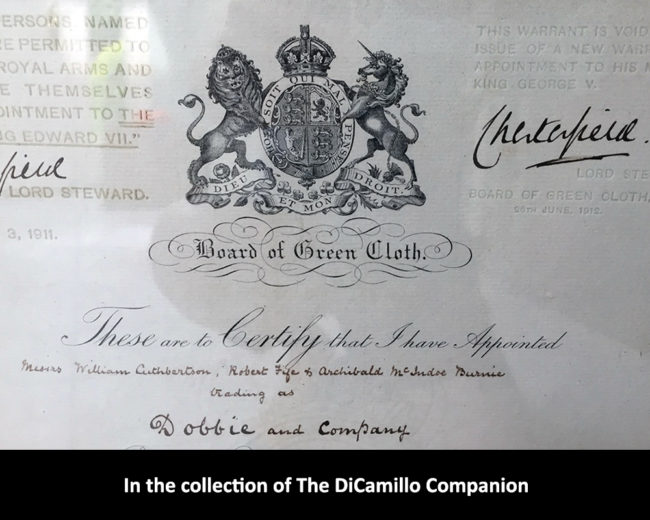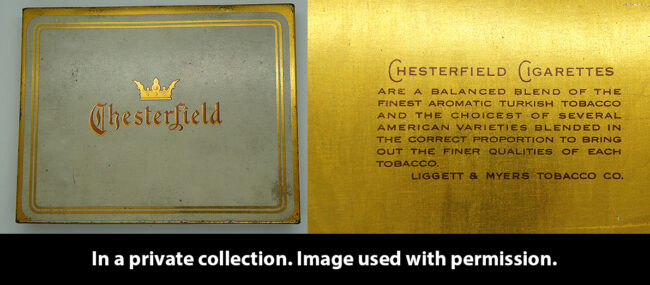
The house and the famous cedar tree from a circa 1910 postcard

This chimneypiece, originally made for the dining room at Chesterfield House, London, was later installed at Bretby Park, from whence it was sold to the Hearst Foundation, who donated it to the Met in 1956.

Vermeil casters from the 4th Earl of Chesterfield's ambassadorial service, today in the collection of the Museum of Fine Arts, Boston.

The 1911 royal warrant issued to Dobbie and Company by the Board of Green Cloth, signed the 10th Earl of Chesterfield.

A 1940s American Chesterfield tin cigarette case. The Chesterfield name was used on more branded products in America than any other British aristocratic title.
Earlier Houses: There were a number of earlier houses on, or near, the site of the current house. The last of these was demolished between 1777 and 1781 to make way for the early 19th century house.
House & Family History: Bretby owes its name - "the dwelling place of Britons" - to Danish invaders who wintered in Repton in 874. In 1209 Ranulph, Earl of Chester, granted the "vil" of Bretby to Stephen de Segrave, who built a church and mansion at the foot of Bretby Mount. In 1585 Thomas Stanhope purchased the manor of Bretby; in 1616 his grandson, Philip, was created Baron Stanhope of Shelford. In 1628 Charles I raised Philip to the earldom of Chesterfield. It is a tradition that Charles, as Prince of Wales, spent three nights at Bretby as the guest of Lord Stanhope in 1623. The 2nd Earl made substantial improvements to the mansion and laid out a magnificent series of gardens which, in 1705, were described as the finest in Europe, save those at Versailles. In 1777 the 5th Earl of Chesterfield decided to demolish the old mansion and replace it with the current house, which was erected to the designs of Jeffry Wyatville in the early 19th century. The 6th Earl, known as the Racing Earl, constructed a trial racecourse two miles in length in the park, while the 7th Earl, who was more interested in cricket and shooting, constructed a cricket pitch and introduced bracken into the park as cover for game. Following the death of the 7th Earl in 1871, the estate passed to his widowed mother, the Dowager Countess, whose good friend, Benjamin Disraeli, paid frequent visits to Bretby. On the death of the countess, her estates devolved upon Lord Porchester, the eldest son of her daughter, Evelyn, who married the 4th Earl of Carnarvon. In 1925 the Derbyshire County Council purchased the estate and opened it in 1926 as an orthopedic hospital. The house was sold in the early 1990s; in 2002 it was converted into condos.
House Replaced By: In 1989 Richard Perkins completed the creation of a new seat called Bretby Park. Taking the 17th century Dower House on the Bretby Estate (originally a keeper's lodge), Perkins hired Digby Harris to transform it into a modern house in the Palladian style.
Collections: A pair of vermeil casters with the arms of King George II, made 1727-28 in London by Paul Crespin and Abraham Buteaux as part of the 4th Earl of Chesterfield's ambassadorial plate service, is today in the collection of the Museum of Fine Arts, Boston (see photo in "Images" section). A white marble fireplace made for Chesterfield House, London, and later installed at Bretby, is today in the collection of the Metropolitan Museum of Art (see "Images" section).
Architect: Jeffry Wyatville (Wyattville) (Wyatt)
Date: Circa 1813-15Architect: William Martin
Date: Circa 1811-13Architect: Digby Harris
Date: 1985Architect: Samuel Beazley
Date: 1830sJohn Bernard (J.B.) Burke, published under the title of A Visitation of the Seats and Arms of the Noblemen and Gentlemen of Great Britain and Ireland, among other titles: 2.S. Vol. II, p. 103, 1855.
Title: Derbyshire Country House, The
Author: Craven, Maxwell; Stanley, Michael
Year Published: 1991
Publisher: Derbyshire: Breedon Books
ISBN: 0907969968
Book Type: Hardback
Title: Biographical Dictionary of British Architects, 1600-1840, A - HARDBACK
Author: Colvin, Howard
Year Published: 2008
Reference: pgs. 114, 681, 1200
Publisher: New Haven: Yale University Press
ISBN: 9780300125085
Book Type: Hardback
House Listed: Grade II*
Park Listed: Grade II
Past Seat / Home of: SEATED AT EARLIER HOUSES: Stephen de Segrave, 13th century. Thomas Stanhope, late 16th century; Philip Stanhope, Baron Stanhope of Shelford and 1st Earl of Chesterfield, 17th century; Philip Dormer Stanhope, 4th Earl of Chesterfield, 18th century. SEATED AT CURRENT HOUSE: Philip Stanhope, 5th Earl of Chesterfield, early 19th century; George Philip Cecil Arthur Stanhope, 7th Earl of Chesterfield, 19th century; Stanhope family here from 1585 until the 1920s. Henry George Alfred Marius Victor Francis Herbert, 6th Earl of Carnarvon, 20th century.
Current Ownership Type: Corporation
Primary Current Ownership Use: Flats / Multi Family